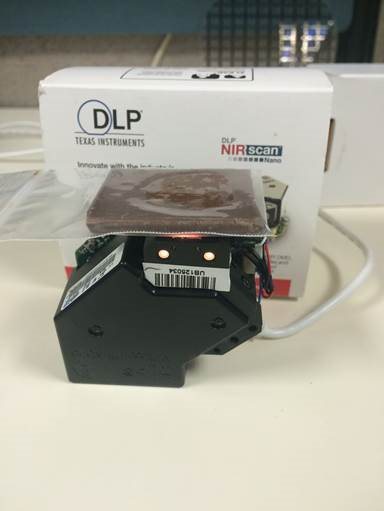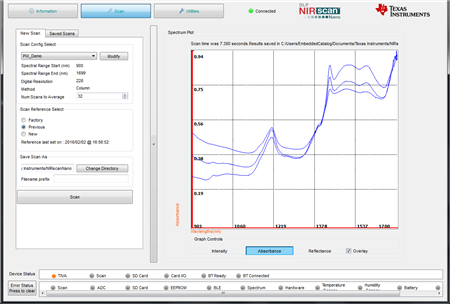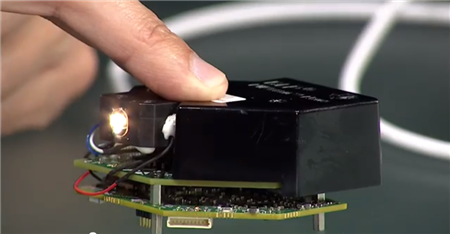SSZTBN0 February 2016 DLP2010NIR , DLPA2005 , DLPC150
Roses are red,
Violets are blue,
We used a TI DLP® NIRscan™ Nano EVM,
To pick the right chocolate for you.
Love may be fleeting, but at least we’ll always have chocolates.
While there’s nothing sweeter for your sweetheart than a box of chocolates on Valentine’s Day, choosing the option with just the right balance of cocoa and sugar content for your taste buds can be a lovelorn experience.
 Figure 1 The DLP NIRscan Nano EVM in
action.
Figure 1 The DLP NIRscan Nano EVM in
action.At TI DLP Products, we decided to address this candy conundrum with our DLP NIRscan Nano evaluation module (EVM). We scanned unidentified samples of chocolate and compared it to a database of known milk chocolates and dark chocolates of approximately 70 percent cocoa and 85 percent cocoa.
Based on the known chocolates in the database, here’s what our testing found:
- 70 percent dark chocolate = approximately 27.5 percent sugar
- 85 percent dark chocolate = approximately 12.5 percent sugar
- Milk chocolate = approximately 52.4 percent sugar
The DLP NIRscan Nano EVM is optimized for a 900 to 1,700 nanometer wavelength range and features a 6,000:1 signal-to-noise ratio. The results shown below were taken directly from the EVM’s included graphical user interface (GUI). We observed the absorbance levels of all three varieties of chocolate across this wavelength range. When compared to the absorbance spectrums in the database, we could identify which chocolates were 70 percent cocoa, 85 percent cocoa, or milk chocolate.
 Figure 2 This screen shot of the GUI
plots the absorbance results of the three types of chocolate we tested.
Figure 2 This screen shot of the GUI
plots the absorbance results of the three types of chocolate we tested.So Much More than a Box of Chocolates
Of course, the NIRscan Nano EVM can help determine more than just sugar content.
The EVM is an evaluation tool to help developers quickly design spectrometers and chemical analyzers using DLP chips. It uses our DLP technology in conjunction with a single element InGaAs detector to deliver high performance measurements in a portable form factor that is more affordable than expensive InGaAs array detectors or fragile rotating grating architectures. The wide NIR-window transmittance also makes it useful in a variety of industries such as agriculture, petrochemicals, and health care.

DLP NIRscan Nano EVM: Getting Started Out of the Box
The design can be powered via USB or batteries and is packed with TI components, including the DLP2010NIR digital micromirror device (DMD), DLPC150 digital controller, and DLPA2005 power management and LED/lamp driver. The DLP2010NIR chip is our smallest, most efficient DLP chip, designed for handheld near-infrared sensing application areas.
Now you can identify the right chocolate for your taste buds from a box of chocolates and know just how much sugar these three types of chocolate contain. How sweet is that?